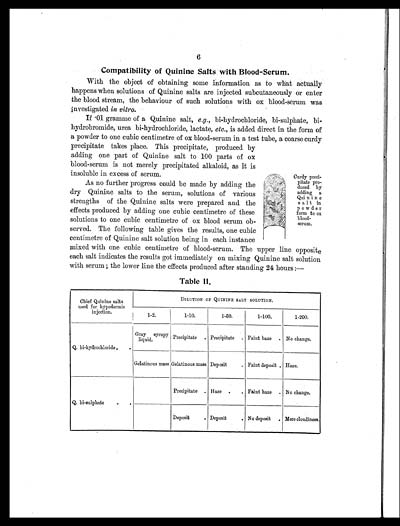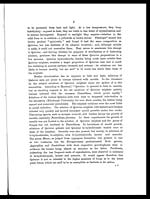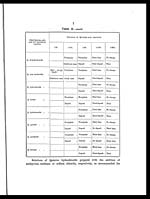Medicine - Institutions > Army health reports and medical documents > Scientific memoirs by officers of the Medical and Sanitary Departments of the Government of India > Number 41 - Quinine and its salts > Quinine and its salts : their solubility and absorbability
(16) Page 6
Download files
Individual page:
Thumbnail gallery: Grid view | List view

6
Compatibility of Quinine Salts with Blood=Serum.
With the object of obtaining some information as to what actually
happens when solutions of Quinine salts are injected subcutaneously or enter
the blood stream, the behaviour of such solutions with ox blood-serum was
investigated in vitro.
If .01 gramme of a Quinine salt, e.g., bi-hydrochloride, bi-sulphate, bi-
hydrobromide, urea bi-hydrochloride, lactate, etc., is added direct in the form of
a powder to one cubic centimetre of ox blood-serum in a test tube, a coarse curdy
precipitate takes place. This precipitate, produced by
adding one part of Quinine salt to 100 parts of ox
blood-serum is not merely precipitated alkaloid, as it is
insoluble in excess of serum.
[NLS note: a graphic appears here - see image of 75034201.tif]
Curdy preci-
pitate pro-
duced by
adding a
Quinine
salt in
powder
form to ox
blood-
serum.
As no further progress could be made by adding the
dry Quinine salts to the serum, solutions of various
strengths of the Quinine salts were prepared and the
effects produced by adding one cubic centimetre of these
solutions to one cubic centimetre of ox blood serum ob-
served. The following table gives the results, one cubic
centimetre of Quinine salt solution being in each instance
mixed with one cubic centimetre of blood-serum. The upper line opposite
each salt indicates the results got immediately on mixing Quinine salt solution
with serum; the lower line the effects produced after standing 24 hours:—
Table II.
| Chief Quinine salts used for hypodermic injection. |
DILUTION OF QUININE SALT SOLUTION. | ||||
| 1-2. | 1-10. | 1-50. | 1-100. | 1-200. | |
| Q. bi-hydrochloride. | Gray syrupy liquid. |
Precipitate | Precipitate | Faint haze | No change. |
| Gelatinous mass | Gelatinous mass | Deposit | Faint deposit | Haze. | |
| Q. bi-sulphate | Precipitate | Haze | Faint haze | No change. | |
| Deposit | Deposit | No deposit | Mere cloudiness. | ||
Set display mode to: Large image | Zoom image | Transcription
Images and transcriptions on this page, including medium image downloads, may be used under the Creative Commons Attribution 4.0 International Licence unless otherwise stated. ![]()
| Permanent URL | https://digital.nls.uk/75034199 |
|---|
| Description | Their solubility and absorbability by A.C. MacGilchrist. |
|---|---|
| Shelfmark | IP/QB.10 |
| Additional NLS resources: | |




